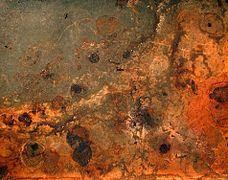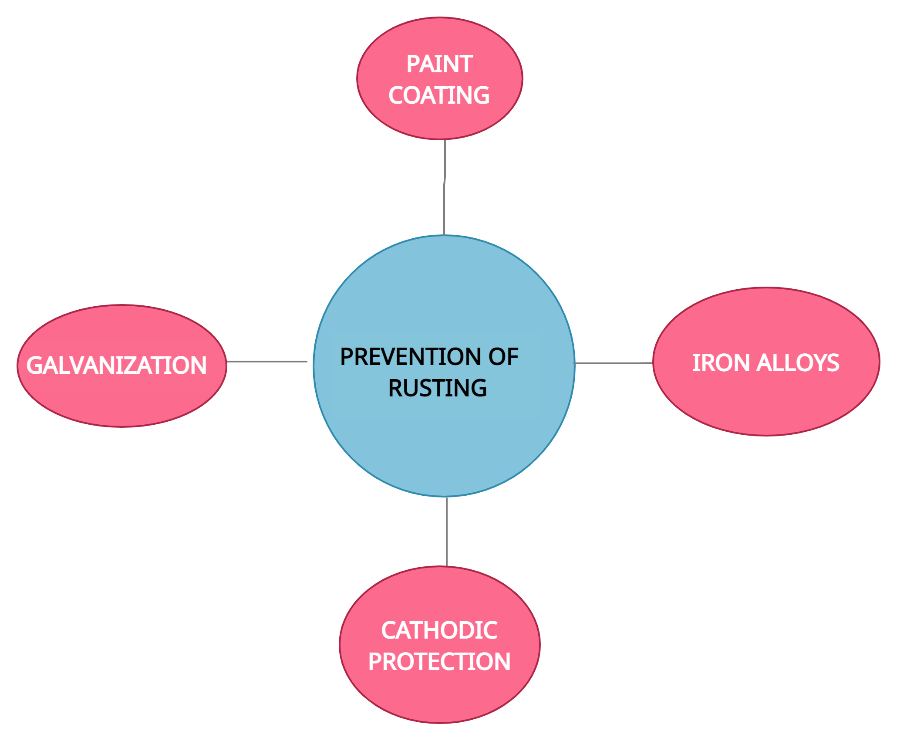Rusting Iron Prevention - Explanation, Formula, Equation, FAQs
Define Rusting and give rusting of iron formula with Rusting of Iron Equation.
Rust is a combination of iron oxides that form on the surface of iron objects or buildings. Rust is formed by the redox reaction between oxygen and iron in a water-rich environment, such as high-moisture air. Rusting is an excellent example of metal corrosion, in which metal surfaces are eroded into more chemically stable oxides. However, the term "rusting" is commonly used to describe the corrosion of iron or iron-alloy items.
NEET 2025: Mock Test Series | Syllabus | High Scoring Topics | PYQs
JEE Main: Study Materials | High Scoring Topics | Preparation Guide
JEE Main: Syllabus | Sample Papers | Mock Tests | PYQs
- Define Rusting and give rusting of iron formula with Rusting of Iron Equation.
- What is the Chemical that Causes Iron to Rust?
- The reaction involved in the rusting of iron
- Factors Affecting the Rusting of iron?
- Why is Rust Basic in Nature?
- How can rusting be prevented?
- Paint Coating
- Alloys of iron
- Cathodic Protection is a type of corrosion protection.
- Galvanization

What is the Chemical that Causes Iron to Rust?
Rust forms on iron or some of its alloys in the presence of water and oxygen. It takes a long time for the reaction to develop. Iron oxides are formed when iron atoms and oxygen atoms form bonds. The oxidation state of iron increases with rusting, resulting in the loss of electrons. Fe2O3.3H2O (hydrated iron (III) oxide) is the chemical formula for rust.
Also read -
- NCERT Solutions for Class 11 Chemistry
- NCERT Solutions for Class 12 Chemistry
- NCERT Solutions for All Subjects
The reaction involved in the rusting of iron
Rusting of iron reaction:
4Fe + 3O2 → 2 Fe2O3
When Fe2O3 comes into contact with water, it becomes Fe2O3.3H2O.
Rust is formed by the reaction of two distinct iron oxides with different oxidation states in the iron atom.
Iron (II) oxide, often known as ferrous oxide, has an oxidation state of +2 and the chemical formula FeO.
Iron (III) oxide, often known as ferric oxide, is a compound in which the iron atom has a +3 oxidation state. Fe2O3 is the chemical formula for this substance.
We all know that oxygen is a great oxidizer and that iron is a great reducer. As a result, when exposed to oxygen, iron atoms freely give up their electrons.
Fe → Fe2+ + 2e-
The ferrous ions get oxidized to ferric ions in presence of moisture as well as air also generating hydroxyl ions along with yielding ferric hydroxide.
4Fe2+ + O2+ 2H2O →4Fe3+ + 4OH-
Fe3+ +3OH- → Fe (OH)3
Fe (OH)3 converts into Fe2O3.3H2O.
Read more :
- NCERT notes Class 12 Chemistry Chapter 3 Electrochemistry
- NCERT solutions for Class 12 Chemistry Chapter 3 Electrochemistry
- NCERT Exemplar Class 12 Chemistry solutions Chapter 3 Electrochemistry
Factors Affecting the Rusting of iron?
The presence of water and oxygen is required for all rusting chemical processes. The amount of oxygen and water surrounding the metal can be limited to prevent it from rusting.
The other factors involved are:
Moisture: The availability of water in the environment limits the corrosion of iron. The most prevalent cause of rusting is exposure to rain.
Acid: The rusting process is accelerated if the pH of the environment around the metal is low. When iron is exposed to acid rain, it rusts more quickly. Iron corrosion is slowed by a higher pH.
Salt: Due to the presence of various salts in the water, iron rusts more quickly. Many ions in saltwater speed up the rusting process through electrochemical processes.
Impurity: When compared to iron having a variety of metals, pure iron rusts more slowly.
Why is Rust Basic in Nature?
Rust is generated when iron oxidises in the presence of moisture in the air. Rust is mostly composed of the metallic oxide Iron (III) oxide [Fe2O3.nH2O]. As a result, all metallic oxides are basic in nature.
Related Topics Link, |
How can rusting be prevented?
Paint Coating
Rusting can be avoided in a variety of ways. One way is to paint iron to protect it from corrosion. Because paint prevents oxygen and water from directly contacting iron, the layers of paint prevent rust from forming on the surface. As long as the paint is present, the iron is shielded from corrosion. Oil-based paints are the most convenient and highly recommended.
Rusting can also be avoided by applying a thermoplastic or thermoset polymer powder coating to the iron surface. Powder coating is preferred over paint because it provides a thicker protective layer. Spraying a dry, organic powder on the iron surface and heating it to the powder's melting point. When the powder is melted, it forms a uniform layer on the iron surface. Vinyl, polyester, nylon, acrylic, urethane, and epoxy-based organic compounds are all common powder coating ingredients.
Alloys of iron
Other options include combining iron with other metals. Stainless steel, for example, is primarily composed of iron with a small percentage of chromium.
Cathodic Protection is a type of corrosion protection.
Making iron a galvanic cell cathode is a crucial way to keep it from rusting. Cathodic protection is the name for this technique. It can be used on any metal, not just iron. Iron is linked to a more active metal, such as magnesium or zinc, in this process. The reduction potential of the more active metals is lower. The other metal (iron) then acts as a cathode, preventing oxidation. When anodes are carefully monitored and replaced on a regular basis, this procedure is extremely useful for storing iron tanks underwater. Metal parts of water heaters are also protected using this method.
NCERT Chemistry Notes:
Galvanization
Iron is galvanised or zinc-plated in a distinct strategy. Zinc has a lower reduction potential than iron, allowing it to oxidise more quickly. Zinc is a metal that is more active. Galvanization is the term for this process. To generate a protective layer, the metal (iron) is covered with another metal, such as zinc. Galvanization can be accomplished in one of two ways:
Hot-dip galvanization: entails immersing the iron in a bath of molten zinc that is extremely hot.
Electro-galvanization: is a process that involves employing zinc metal as an anode, iron as a cathode, and sending electricity through a zinc solution to coat the iron surface evenly with zinc.
Electro-galvanization is the predominant method of galvanization nowadays because, unlike the hot-dip approach, it creates a uniform coating.

Also check-
Frequently Asked Questions (FAQs)
b. Acetic Acid
A small amount of acetic acid accelerates the corrosion of lead. When acetic acid reacts with lead in the presence of oxygen, it forms extremely soluble lead (II) acetate, making it impossible to utilise lead to process or preserve wine or fruit juice.
Rusting of iron is an example of redox reaction where reduction and oxidation takes place and hence both option A and option C are correct.
Rust is formed when iron is oxidized in presence of moisture. The rusting of iron is chemical change because it is two substances reacting together to make new substance.
Fe + H2O + O2 → Fe(OH)3 → Fe2O3.nH2O(rust)
The production of rust, a combination of iron oxides, on the surface of iron objects or buildings is referred to as rusting of iron. In a water-rich environment, rust is created through a redox interaction between oxygen and iron.
To prevent corrosion, many different types of coatings can be applied to the exposed metal's surface. Paints, wax tapes, and varnish are all examples of corrosion-resistant coatings.
Galvanization is the process of coating a metal with a protective layer of zinc. It is a standard way of protecting iron from rusting. Adding an electric charge to metals can help prevent corrosion by inhibiting electrochemical processes.
Water causes iron to react with oxygen by splitting the oxygen atom. During the early phases of rusting, iron loses electrons and oxygen gets electrons. The ferrous and ferric ions subsequently react with water to generate ferrous hydroxide, ferric hydroxide, and hydrogen.
Also Read
17 Dec'24 10:27 AM
12 Dec'24 01:16 PM
09 Jul'22 03:34 PM
08 Jul'22 03:43 PM
08 Jul'22 03:35 PM
08 Jul'22 03:32 PM
08 Jul'22 03:09 PM
08 Jul'22 03:03 PM
07 Jul'22 03:03 PM